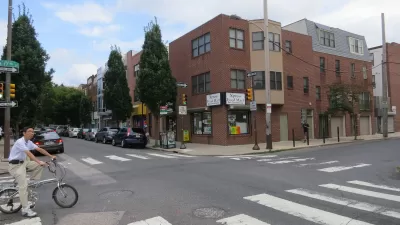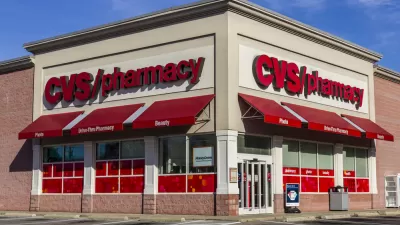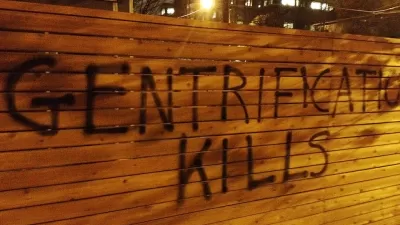The corner café on North Second Street in the Northern Liberties neighborhood of Philadelphia aspires to Euro-style café culture though it lines a little-trafficked street of row houses showing every year of their century and a half of existence, and faces a vast empty, chain-linked block where a brewery once stood.
The corner café on North Second Street in the Northern Liberties neighborhood of Philadelphia aspires to Euro-style café culture though it lines a little-trafficked street of row houses showing every year of their century and a half of existence, and faces a vast empty, chain-linked block where a brewery once stood. 
It's part of Liberties Walk, built by Tower Investments, and self-consciously styles itself an arts enclave (though I was a bit mystified if it was about art or merely artsy). Artists have driven the slow but steady gentrification of the Northern Liberties since the early 1980s. Tower's development seems to have been generated right out of the development-follows-arts playbook codified by Richard Florida in his influential Rise of the Creative Class.
If it has, it's because Florida's formulation works in spite of critics who wish he'd stop touting artists, students and gays as engines of urban rebirth and focus on the "real" economy, whatever that is these days. But the unusual development approach has also been made possible by the length and breadth of America's housing boom, especially in older cities long shunned by conventional lenders and developers.
With its apartments mounted on top of non-chain boutique retail, Liberties Walk is the kind of development that could not have garnered conventional financing just a few years ago. Years of low interest rates, the more open-minded approach (some would say giddiness) of lenders, and their late recognition of urban amenity have permitted developers to transcend tired, me-too "product."
Its success led the developer to build the NoLi housing (will they stop with the faux remixings on "SoHo"?) across North Second Street.

The rumpled façade may be marketing its hipness hard, but architect Erdy McHenry has inventively mixed duplex units that deliver light, space, and views on a tight budget. (The recesses visible along the façade are small gathering spaces that enliven the long, skinny internal hallways.) More importantly, the architects have created an architectural presence that is architecturally magnetic – creating excitement that draws additional investment as well as tenants. (Its second phase nears construction.) It's an assertion of faith in the future -- very important in a city that's still hemorrhaging people, and where dozens of neighborhoods have seen little investment in decades.
It's in striking contrast to the usual timid, low-grade infill and rehab that has been inflicted on cities desperate for any investment. The boxy stripped-down suburban Georgians that developers wedged into small city lots back in the 1980s (when irrational real-estate exuberance last reigned) are looking mighty tired now. They've been milked of all their value, and sit sucking energy from the street rather than adding to it.
Another aspect of Northern Liberties gentrification that differs from in-city growth even a few years ago is how quickly chains move in. A Victorian building of muttlike architectural heritage has been handsomely rehabbed for the Hyperion Bank.

Of course officials at this bank (and the two others I found nearby) have read Florida's books and have hustled to harvest the buyer influx, sometimes with unnerving results.

Others have been able to add inventive compositions to the streetscape that less pioneering neighborhoods often resist.

(This one's by Plumbob, an architect and design/builder temporarily found here.)
Will it last? I can't say – certainly the investment winds are chillier in Philadelphia these days. But I hope it works.

The city has too long felt like this. This structure, embalmed in stucco, was probably once a quite assertive mid-19th-century neoclassical church. When it was built, the fortunes of the city probably looked limitless. Perhaps someone will peel off that wrapping and reveal that optimism again.

Alabama: Trump Terminates Settlements for Black Communities Harmed By Raw Sewage
Trump deemed the landmark civil rights agreement “illegal DEI and environmental justice policy.”

Study: Maui’s Plan to Convert Vacation Rentals to Long-Term Housing Could Cause Nearly $1 Billion Economic Loss
The plan would reduce visitor accommodation by 25% resulting in 1,900 jobs lost.

Planetizen Federal Action Tracker
A weekly monitor of how Trump’s orders and actions are impacting planners and planning in America.

Wind Energy on the Rise Despite Federal Policy Reversal
The Trump administration is revoking federal support for renewable energy, but demand for new projects continues unabated.

Passengers Flock to Caltrain After Electrification
The new electric trains are running faster and more reliably, leading to strong ridership growth on the Bay Area rail system.

Texas Churches Rally Behind ‘Yes in God’s Back Yard’ Legislation
Religious leaders want the state to reduce zoning regulations to streamline leasing church-owned land to housing developers.
Urban Design for Planners 1: Software Tools
This six-course series explores essential urban design concepts using open source software and equips planners with the tools they need to participate fully in the urban design process.
Planning for Universal Design
Learn the tools for implementing Universal Design in planning regulations.
Caltrans
Smith Gee Studio
Institute for Housing and Urban Development Studies (IHS)
City of Grandview
Harvard GSD Executive Education
Toledo-Lucas County Plan Commissions
Salt Lake City
NYU Wagner Graduate School of Public Service






























